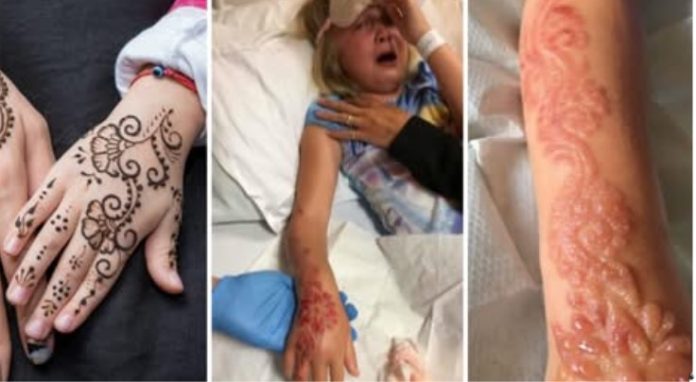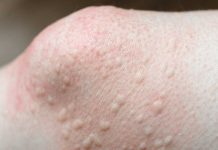When we think about temporary tattoos, we often see them as harmless fun. Children love the idea of getting intricate designs on their skin, feeling like they have a piece of art to show off. Many parents see it as a safe and painless way to let their kids experiment with body art without the commitment of a real tattoo. However, what if that seemingly innocent act turned into a painful and lifelong scar?
This is exactly what happened to 7-year-old Madison in 2018. During what was supposed to be a relaxing family vacation in Egypt, a temporary henna tattoo left her with severe chemical burns. The burns were so extreme that they might scar her body permanently. It’s a tragic reminder that not everything labeled as ‘temporary’ is risk-free, and some of the biggest dangers can be hidden in plain sight.
The Vacation That Took a Horrific Turn
Madison and her family were enjoying their stay at a beautiful 4-star hotel in Egypt. What was meant to be an unforgettable vacation quickly turned into a nightmare when Madison’s mother fell ill with a gallbladder infection. While she was receiving medical care, Madison’s father tried to keep the children entertained. He thought a fun and harmless activity would be getting them temporary henna tattoos.
Henna tattoos have been a popular form of body art for centuries, often associated with cultural and traditional celebrations. However, in recent years, a more dangerous variation has surfaced: black henna. Unlike natural henna, which is a reddish-brown color and takes hours to set, black henna contains added chemicals that speed up the process and darken the ink. Unfortunately, these additives can have harmful effects on the skin.
Madison’s younger brother, Sebastien, was the first to show signs of irritation. His skin became itchy, prompting the family to wash off the henna ink immediately. They assumed it was just a mild reaction. However, Madison’s experience was far worse. Within hours, blisters began to form from her fingers to her elbow. Her skin became inflamed, and the pain was unbearable. What should have been a simple, temporary tattoo had turned into a medical emergency.
What Caused Madison’s Chemical Burns?
Doctors quickly diagnosed Madison with severe chemical burns caused by an ingredient in the black henna ink: paraphenylenediamine (PPD). This chemical is commonly used in hair dyes and dark-colored cosmetics. While it is approved for hair use in the U.S., it is not meant for direct contact with the skin.
Paraphenylenediamine is notorious for causing allergic reactions, hypersensitivity, and even permanent scarring. It is often found in:
- Textile and fur dyes
- Dark-colored cosmetics
- Black rubber
- Printing inks and photocopying materials
- Gasoline, oils, and greases
Its use in temporary tattoos is particularly dangerous because many people falsely believe that these tattoos are completely safe. In reality, hundreds of cases have been reported where individuals suffered from rashes, burns, scarring, and permanent skin discoloration due to PPD exposure. Children, with their more sensitive skin, are even more vulnerable to these toxic effects.
Why Is PPD Used in Henna Tattoos?
Natural henna, derived from the Lawsonia inermis plant, takes time to develop its color. It starts as an orange-brown stain that gradually darkens over 24-48 hours. This slow process doesn’t appeal to many modern-day consumers who want instant results. To cater to demand, many tattoo artists and vendors started adding PPD to their henna mixtures. This creates a deep black stain within minutes and increases the longevity of the tattoo. However, this shortcut comes at a severe cost to health and safety.
According to the U.S. National Library of Medicine and the National Institutes of Health, PPD is an oxidative chemical that has been linked to various allergic and toxic reactions. Despite the dangers, some vendors continue to use it, often unknowingly. When families go on vacation and encounter henna tattoo stands, there’s no way to be sure whether the ink contains PPD unless it has been laboratory tested.
The Rising Cases of Chemical Burns from Henna Tattoos
Madison’s case is not an isolated incident. Across the world, there have been numerous reports of children and adults suffering from burns due to black henna tattoos. Some cases result in lifelong scarring, and others lead to serious allergic reactions that require medical intervention.
- In the UK, a 10-year-old boy suffered burns so severe that his skin was left permanently discolored after getting a black henna tattoo on vacation.
- In Spain, a woman developed painful, itchy blisters after receiving a temporary henna tattoo on a beach.
- In the United States, dermatologists have seen an increase in allergic reactions linked to black henna, with some patients requiring steroid treatments to recover.
The issue is so prevalent that the U.S. Food and Drug Administration (FDA) has issued warnings against the use of black henna, urging consumers to be cautious of its risks.
How Can You Protect Your Children from Dangerous Henna Tattoos?
Given the risks associated with black henna tattoos, parents need to be extra vigilant. Here are some steps to ensure your child’s safety:
- Avoid black henna tattoos altogether – If you’re unsure about the ingredients, it’s best to steer clear of them. Natural henna should always be brownish-red, not black.
- Ask for ingredient lists – If you’re considering a henna tattoo, ask the artist for a list of ingredients. If they can’t provide one, don’t take the risk.
- Perform a patch test – If you ever use henna or hair dye, do a small skin test first to check for any adverse reactions.
- Educate your children – Teach your kids about the dangers of black henna and encourage them to ask questions before getting any temporary tattoos.
- Choose natural alternatives – There are plenty of safe, plant-based body art options available that do not contain harmful chemicals.
- Check travel advisories – Before going on vacation, research the local regulations regarding henna and temporary tattoos to make informed decisions.
A Cautionary Tale for Every Parent
Madison’s story serves as a painful lesson for parents everywhere. Something as seemingly innocent as a temporary tattoo left her with excruciating burns that may leave permanent scars. No parent wants to see their child suffer, especially from something that could have been avoided.
The reality is that not all products marketed as ‘temporary’ or ‘safe’ are actually harmless. As parents, we must be diligent in researching what goes on our children’s skin and be aware of hidden dangers that might not be immediately obvious.
Next time you’re on vacation or at a festival where henna tattoos are offered, take a moment to think twice. Ask questions, seek out natural alternatives, and most importantly, protect your child from unnecessary harm.
After all, a beautiful design on the skin should never come at the cost of health and safety.
Let’s spread awareness and ensure no more children suffer from preventable chemical burns.










